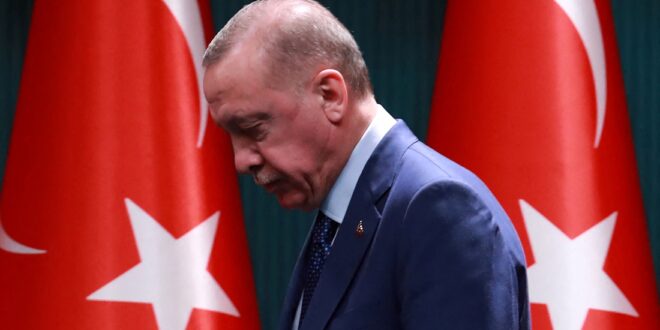Erdoğan’s biggest political rival ahead of the 2023 presidential elections seems to be — poverty.
The first decade of Erdoğan’s rule actually brought relative prosperity to Turks. Per capita GDP rose sharply from $3,688 in 2002 to $11,796 in 2012… Since 2013, however, reckless nepotism, increasing authoritarianism, corruption and economic mismanagement have boosted interest-rates, inflation and unemployment, bringing per capita GDP down to an estimated $7,500.
Nearly half of Turkish workers are minimum wage earners, meaning that millions of families must survive on $233 a month
Unfortunately, since early 2018, the lira has been on a downward slide due to constant geopolitical tensions with the West, widening current account deficits, shrinking foreign currency reserves and mounting public debt.
As the lira crashes to insane historic lows, local salaries are also severely devalued.
Erdoğan is heading fast to becoming the victim of his own miscalculations: a dramatically mismanaged economy and geostrategic challenges that went beyond Turkey’s political and military might.
Perhaps these missteps will be the beginning of the end of Erdoğan’s ugly populism — his neo-Ottoman ambitions that have caused major damage to Turkey’s economy as well as the country’s international isolation.
A punishing economic crisis in 2000-2001, the worst ever in modern Turkish history, pushed millions of Turks below the poverty line. In 2002, Turks went to the ballot box to punish a ruling coalition of mainstream parties and elected as prime minister Recep Tayyip Erdoğan. By a simple twist of fate, nearly two decades later, Erdoğan’s biggest political rival ahead of the 2023 presidential elections seems to be — poverty.
The first decade of Erdoğan’s rule actually brought relative prosperity to Turks. Per capita GDP rose sharply from $3,688 in 2002 to $11,796 in 2012, boosting his popularity. Since 2013, however, reckless nepotism, increasing authoritarianism, corruption and economic mismanagement have boosted interest-rates, inflation and unemployment, bringing per capita GDP down to an estimated $7,500.
In October, Turkey’s official year-on-year inflation rate was 19.89%. Awkwardly, an independent group of academics, ENAG, measured the annualized inflation rate for the month of October at 49.87%.
Nearly half of Turkish workers are minimum-wage earners, meaning that millions of families must survive on about $233 a month.
In mid-2017, when the Turkish lira traded at 3.5 to one U.S. dollar, Erdoğan advised Turks to sell their foreign currencies and invest in the national currency. Unfortunately, since early 2018, the lira has been on a downward slide due to constant geopolitical tensions with the West, widening current account deficits, shrinking foreign currency reserves and mounting public debt.
Erdoğan, who advocates aggressive interest rate cuts, has fired three central bank governors in roughly two years. Since September, he has pushed the central bank to make three interest rate cuts, the most recent in mid-November. He might have been hoping that lower interest rates would boost jobs, exports and growth — a miracle blend of economic outlook that would bring him votes in 2023.
At the time of writing, the Turkish lira had crashed to a record low of 13.88 to the U.S. dollar — well past what just a month earlier had been deemed a psychological barrier of 11 liras to the dollar. Within four and a half years, defying Erdoğan’s advice to invest in Turkey’s currency, the dollar’s value against the lira skyrocketed from 3.5 to 13.88. Only this year, the lira has shed over 42% of its value against the dollar, making it the weakest global currency. On November 23, as markets were in turmoil, Apple halted sales of nearly all of its products in Turkey.
As the lira crashes to insane historic lows, local salaries are also severely devalued. Today, with his monthly salary, a Turkish minimum wage earner can afford 64 small cans of beer.
Turks say that household budgets and future plans are in turmoil. Businesses fare no better. At the end of August 2021, the private sector’s foreign currency debt stock was at $174 billion. Since the beginning of the year, that debt stock, in lira terms, has risen by over 42%, potentially putting thousands of companies at risk of default.
Turks, including Erdoğan’s once loyal supporters, are angry. On November 23, protests in Istanbul and the capital, Ankara, called for an end to the policies that have caused the economic slide, and that have led to an inflationary spiral and the crash of the lira this year. In parts of Istanbul, as protesters vented their fury against the Erdoğan government, police had to erect barriers.
Economic turmoil is an existential threat to Erdogan’s grip on power. Research shows how much bread-and-butter issues matter to Turks, as probably to all voters. The pollster Optimar found that 63.8% of Turks think their biggest problem is the economy and unemployment. Optimar also found that only 27.8% of Turks think Erdoğan can resolve their pressing economic problems.
What can Erdoğan do? He does not seem to have too many options. He may stop challenging market forces and reverse his interest rate policy by raising rates, which then will come with another pre-election cost: an economic slowdown. He try to can tap into the vaults of rich friends such as Qatar for cash infusions and investment. That would at least be a temporary relief for an economy suffering fundamental imbalances.
Erdoğan is heading fast to becoming the victim of his own miscalculations: a dramatically mismanaged economy and geostrategic challenges that went beyond Turkey’s political and military might.
Perhaps these missteps will be the beginning of the end of Erdoğan’s ugly populism — his neo-Ottoman ambitions that have caused major damage to Turkey’s economy as well as the country’s international isolation.
 Eurasia Press & News
Eurasia Press & News



